 |
The News Service | |||
Profiles | ||||
|
Physical science departments welcome nine new faculty for 2005-06
Nine new members of the regular faculty will begin their work in life sciences at Brown this fall, including Volker Elling in applied mathematics; Shouheng Sun in chemistry; Sorin Istrail in computer science; Huajian Gao and Thomas Webster in engineering; James Russell in geological sciences; James Kelliher, Stephen Miller, and Richard Schwartz in mathematics. 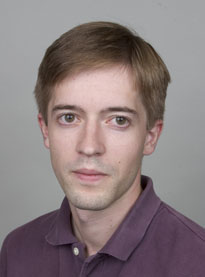 Volker Elling Historically, engineers working in the commercial aviation industry or for NASA have used wind tunnels to test the flow of air around objects. But wind tunnels are expensive to build and operate. Increasingly, engineers and researchers turn to computer simulations instead of wind tunnels when they want to test their designs. But are these computer simulations accurate? Could the results ever be off? That’s what Volker Elling wants to know. “A part of my research looks for special examples of gas flow where computers deliver a totally wrong answer. I look at why computer simulation programs fail.” As a teen-ager, Elling was interested in computer programming. He studied computer science as an undergraduate, but switched to mathematics when his interest in the theoretical outpaced his interest in programming. He received his Ph.D. from Stanford University’s Scientific Computing and Computational Mathematics Program last January. His dissertation is titled A Lax-Wendroff Type Theorem for Unstructured Grids. Elling has worked on self-similar potential flow and uniqueness of entropy solutions. He is interested in the theory and numerics of nonlinear hyperbolic systems of conservation laws (especially compressible flow) and in the theory of mixed type equations. Recent papers accepted for scientific publications include “The Ellipticity Principle for Steady and Self-Similar Polytropic Potential Flow” and “Nonuniqueness of Entropy Solutions and the Carbuncle Phenomenon.” For someone with his research interests, “it would be hard to find a better place than Brown’s Division of Applied Mathematics,” Elling said. “It is a very good environment.” 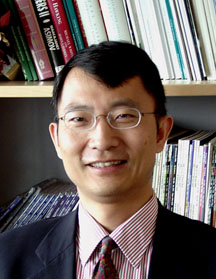 Huajian Gao One of the most important new developments in solid mechanics is nanomechanics, an interdisciplinary field that aims to reveal the basic principles of how complex systems function in nature and in engineering. Huajian Gao, professor and director of the Max Planck Institute for Metals Research in Stuttgart, Germany, considers nanomechanics “a key field at the boundary between engineering, biology and medicine.” His research regularly explores the merging of these boundaries. Gao joins the Brown faculty in January. One line of Gao’s research is biological. He aims to find out how nature designs hierarchical and multifunctional materials, such as bone. “Bone is a very intelligent material with multiple levels of structural hierarchies capable of resisting, sensing and repairing mechanical damages,” he said. “The study of hierarchical design of bone and bone-like materials is an important subject for nanomechanics.” Along engineering lines, Gao wants to determine which principles can be used to develop novel functional materials for industrial applications. To do so, he studies the mechanical properties of a variety of nanocrystalline materials and thin film materials used in microelectronic and other industries. The research crossing into medicine delves into cell and molecular biomechanics. “Nanomechanics play an important role in helping to design model systems (such as synthetic molecules, vesicles and the like) to understand the biological phenomena that are critically important to human health,” he said. Gao has a background in engineering science and applied mechanics. His research interests in the past covered stress and diffusion processes in various thin films systems, size-dependent plastic deformation at micron and submicron length scales, and dynamic fracture in brittle solids. His expertise often brings him into collaboration with scientists around the world, including work with Brown Professor of Engineering L.B. Freund. The University’s solid mechanics group “has been a worldwide leader in the field for more than half a century,” said Gao, and is one reason he accepted the offer to join the Brown faculty. “It is really a privilege and honor for me to have the opportunity to contribute and further promote the discipline of engineering science at Brown,” he said. Gao has taught at a number of institutions, including Stanford University (1988-2002), and at the Max Planck Institute since 2001. His goal as an educator is “to be able to explain a complex subject in a simple way. My hero in teaching is American physicist Richard Feynman,” a 1965 Nobel Prize winner “who famously said that a good scientist should be able to explain his subject to a freshman class and make everyone understand his point.” 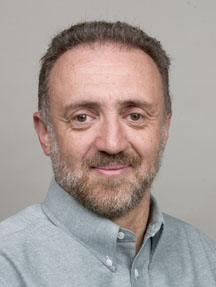 Sorin Istrail The “Genome Era” started in 2001 when the Human Genome Project and Celera Genomics published the first assemblies of the human genome. Since then, high-throughput biotechnologies have generated genomic and proteomic data sets of unprecedented magnitude and complexity. Emerging from this data is an “informatics renaissance” led by computer science’s new algorithmic, visualization and computing paradigms. Computational biology – with insights from experimental molecular biology, physics, chemistry and economics – is harnessing the complexity of biological systems by providing computational models and genomics tools that transform knowledge into scientific control over life science processes. Sorin Istrail, in his role as senior director and then head of the Informatics Research Group of Celera Genomics, has been instrumental in the company’s human genome research. “My role was to lead the computational biology effort at Celera in the post-genome assembly phase. I built a dream team of genomic toolmakers. By creating powerful software libraries of tools for assembly comparison, annotation, mass spectrometry, SNPs and haplotypes, arrays, protein folding, and literature data mining, the informatics research team became, arguably, the leading computational biology group in the industry,” Istrail said. Celera’s labs teemed with energy as some of the world’s best scientific minds united in a common goal. “It was a once-in-a-lifetime experience and accelerated by at least 10 years the accessibility of genomes,” Istrail said. “I loved working with opinionated, workaholic overachievers who, when tasked by inspiring leaders with solving exceedingly hard problems, made lasting scientific advances as a team,” he said. “This defines the Celera spirit – a spirit I would like to recreate in an academic setting. “You need the smartest students, the best faculty, and they’re here at Brown. We must work on the hardest problems.” Biology is changing everything, especially computer science, Istrail said. The next generation of computer scientists will need to be renaissance men and women, with interests and skills not only in computer science, but in biology, physics, chemistry, and economics. “We need to rethink and reteach, to cross computer science with the interdisciplinary work in wet and dry labs. ... The most exciting and novel courses will mix experiments with computation.” Istrail will hold the first chaired professorship at Brown’s Center for Computational Molecular Biology. Before coming to the University, Istrail was a visiting associate at California Institute of Technology. He was at Celera Genomics from April 2000 through February 2005. Previously, he led the Computational Biology Project at Sandia National Laboratories (1992-2000), taught at Wesleyan University, and was a visiting scientist at MIT from 1985 until 1992. In 2000, he resolved a longstanding open problem in statistical mechanics, the Three-Dimensional Ising Model Problem. He is co-editor-in-chief of the Journal of Computational Biology, co-founder of the RECOMB Conference Series, co-editor of the MIT Press Computational Molecular Biology book series, and co-editor of the Springer-Verlag Lecture Notes in Bioinformatics book series. 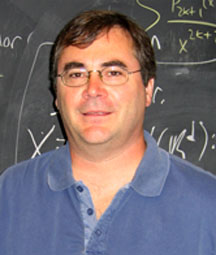 James Kelliher The mathematical problems of incompressible fluid mechanics intrigue Jim Kelliher, who earlier this year completed his doctorate in mathematics at the University of Texas at Austin. After spending nearly two decades as a software developer, Kelliher began graduate studies at George Mason University, where he received his Master of Science in 2000 before entering the doctoral program at Austin. “Like many students, I entered graduate school with wide-ranging interests in mathematics, and went through a process of self-discovery,” he said. Finding analysis his strength, Kelliher was ultimately led to the field of mathematical fluid mechanics. In 2004, Mathematical Research Letters published a paper by Kelliher titled “The inviscid limit for two-dimensional incompressible fluids with unbounded vorticity.” “The inviscid limit has been fascinating to me,” he said, “because of the understanding it requires of both the Navier-Stokes and the Euler equations” – those equations describing, respectively, the motion of a fluid with and without viscosity. He plans to continue to explore this and related topics, using it as an entry into the broader field of fluid mechanics. In the near term, Kelliher would like to continue his work on the inviscid limit, exploring convergence in various function spaces, in a bounded domain with non-standard boundary conditions, and of statistical solutions – each a “natural outgrowth of the work I have done so far,” he said. “I believe these three projects are deep enough problems to consume my efforts for at least two years, but of a level of difficulty that allows a reasonable chance of success.” Kelliher accepted the offer to join the Brown faculty because the University has “one of the best mathematics departments in the country,” he said. He will teach an undergraduate calculus course in the fall and courses in calculus and differential equations in the spring. 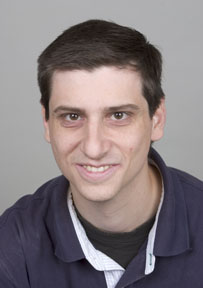 Stephen Miller Steven J. Miller’s research takes him into the world of number theory, with an occasional foray along the boundary of probability and statistics. “I love how you see similar behavior in such diverse systems,” Miller says, “from prime numbers, to energy levels of uranium, to eigenvalues of matrices.” His current research is one such example. Miller is finding ways to compare the similarities of the behavior of zeros in certain number theory functions to the behavior of energy levels of heavy nuclei, like those in uranium. As an educator, Miller has found that even beginning mathematics students can grasp many of the great questions in number theory. Though the techniques to arrive at the solutions eventually require more advanced mathematics, “beginning students can quickly get a feel for what’s out there, and with the increasing power of computers, do nontrivial calculations to support or reject these conjectures,” he says. In a new book tentatively titled An Invitation to Modern Number Theory, Miller and co-author Ramin Takloo-Bighash of Princeton fuel students’ curiosity. “Using as few prerequisites as we can, we introduce students to many of the questions in modern number theory, as well as providing possible research projects for those interested in pursuing these questions further,” Miller says. Princeton University Press will publish the book in the spring. For the last five years, Miller has explored the riddles of number theory with undergraduate and graduate students at Princeton, the Courant Institute at New York University, the American Institute of Mathematics, Ohio State, and as a visiting faculty member last year at Brown. “I love both mathematical research and teaching,” Miller says. The research classes and programs he has designed and led “have been an ideal way to combine the two.” Miller received his undergraduate degree in mathematics and physics from Yale University (1996), and his master’s (1998) and doctorate (2002) in mathematics from Princeton. In the fall, Miller will teach abstract algebra; in the spring, he will teach a theoretical statistics course, and a First Year Seminar titled “From Riddles to Modern Mathematics.” 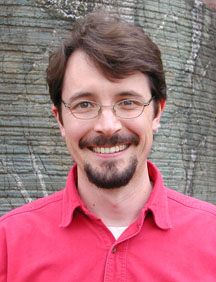 James Russell James Russell is a limnologist, a fresh-water sleuth. Russell concentrates on lakes. He studies small crater lakes in Indonesia and also the grand African sort. By examining the rise and fall of Lake Tanganyika or, say, changes in the chemical composition of Lake Victoria, Russell aims to understand the role lakes play in shaping Earth’s climate – and what they can tell us about the planet’s climatic past. Lakes play an obvious role in how the planet processes heat and moisture to make rain and snow, floods and droughts. Take the Great Lakes. They help fuel epic dumps of white stuff each winter throughout the Midwest, Northeast and Canada, a phenomenon that anyone in Buffalo would recognize as the “lake-effect snowstorm.” But the Great Lakes had a lasting effect on global climate roughly 8,000 to 15,000 years ago. During deglaciation, ice sheets damming several of the lakes broke free, pushing massive amounts of fresh water through the St. Lawrence and out into the Atlantic Ocean. This altered deep ocean circulation, which in turn dropped temperatures in parts of North America and Europe by 5 to 10 degrees. This historical record interests Russell, an assistant professor of geological sciences. The 30-year-old researcher plies lakes for clues to climate history – a history that can help scientists make predictions about future rainfall and droughts. “My ultimate goal is to reconstruct a record for the climate history of Africa and Indonesia,” Russell said. “By looking at this history of the tropics – where most of the planet’s heat is absorbed – we can begin to make predictions about future changes in rainfall. We need to know what came before we can know what to expect in the future.” Such information is important, given worries about how global warming and the warm ocean currents of El Nino will affect crops and ocean catches. “What we learn can have enormous implications,” Russell said. “Rainfall changes have an obvious impact on food supplies. For example, a major source of protein in Africa is lake fish. If there is a multidecade drought, the effects on fisheries could fuel a famine.” So how do you create a climate record from a lake? Make a “mudsicle.” This is what Russell calls the long, skinny sediment samples he collects during fieldwork. The samples, pulled from lakebeds by tubes drilled into the muck, offer a physical record of climate and geological change. The density or salinity of the sample, or the presence or absence of certain silts, clays, minerals and microfossils, offer signs of erosion, earthquakes and floods. One 10-meter sample offers about 10,000 years of history. Russell, a researcher at the Limnological Research Center at the University of Minnesota, will continue his tropical lake work when he arrives on the Brown campus in January. Russell studied earth and environmental science at Wesleyan University, where he studied miniature orchids in Tanzania and explored Lake Albert in Uganda – experiences which whetted his appetite for limnology and sparked his passion for Africa. He plans to take his Brown students to the continent for research. “It’s the best way,” he said, “to see how science works.” – Wendy Y. Lawton 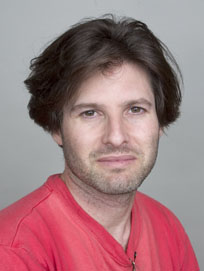 Richard Schwartz Richard Schwartz thinks he may have been born interested in mathematics. “When I was a little kid, I was very interested in numbers and shapes, and in the limitless extent of space,” he says. Those interests waxed and waned until Schwartz enrolled at University of California-Los Angeles as an undergraduate and “discovered that I could just read math books on my own and direct the course of my study.” That little kid’s curiosity about numbers and shapes became the grown mathematician’s research: Schwartz has written more than 25 papers that have made fundamental contributions to geometric group theory, complex hyperbolic geometry, and hyperbolic dynamics. Schwartz, who received his doctorate from Princeton in 1991, comes to Brown from the University of Maryland-College Park, where he has taught since 1997, most recently as professor of mathematics. Previously, he taught at the University of Chicago. He also held several postdoctoral fellowships, including an Einstein Postdoctoral Fellowship at City University of New York and a National Science Foundation Postdoctoral Fellowship at the University of California-San Diego and at the University of Maryland. His many honors include a 1996 Alfred P. Sloan Fellowship, which provides support and recognition to early-career scientists and scholars, and a Guggenheim Fellowship in 2003 to pursue his research of the connections between real and complex hyperbolic discrete groups. What attracted Schwartz to Brown? “The small and informal nature, as well as the strong spirit of academic freedom – not to mention the very high caliber of the math department,” he says. As an educator, Schwartz tries to follow two basic principles: “Understand the course material completely and explain it clearly, and treat the students with respect. I like to run an informal and friendly class that nonetheless challenges the students and presents the ideas rigorously and in a compelling way,” Schwartz says. “I don’t like to force students to enjoy or excel at mathematics, but I get very happy when I meet enthusiastic and talented students.” 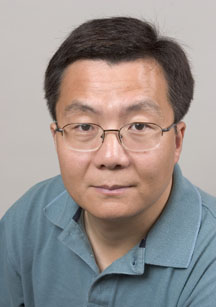 Shouheng Sun After he received his doctorate in chemistry from Brown University in 1996, Shouheng Sun joined IBM’s T.J. Watson Research Center, first as a postdoctoral fellow, and later as a staff scientist. While working at the Watson Research Center, Sun’s nanoparticle research explored the development of magnetic nanoparticles. These have attracted great interest because of their potential applications in ultrahigh-density magnetic recording, highly sensitive magnetic sensors and advanced nanocomposite permanent magnets. But Sun returned to Brown as a faculty member last January, drawn by the freedom of academic research in general, but especially by “Brown’s long-term commitment to research and education, especially its recent effort in nanoscience and nanomedicine,” he said. Sun’s nanomaterial research at Brown involves two related areas: chemical synthesis and self-assembly of nanoparticles, and construction and elaboration of nanoparticles and their assemblies for use in a variety of applications. With Clyde Briant, dean of engineering, Sun has submitted a nanomedical proposal to the National Institutes of Health. Sun also works with engineering Prof. Arto Nurmikko on magneto-optical studies of composite nanostructures, and with chemistry Prof. Dwight Sweigart on rational assembly of nanoparticles. Sun has received several awards for his work, including one from the National Science Foundation of China in 2004 as an Overseas Outstanding Scholar. In 2002, IBM designated him a master inventor – he holds or co-holds several nanomaterials patents, and several others are pending. This fall, Sun will teach “Nanomaterials: Synthesis and Applications,” a section of “Topics in Advanced Chemistry,” with Prof. William Risen. 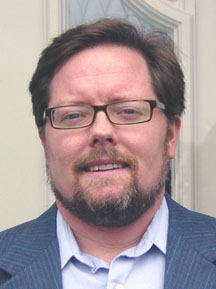 Thomas Webster Thomas J. Webster thinks big by thinking small – really small. His research occurs in the realm of nanomedicine. One area of interest: orthopedic and dental implants. Tissues have nanostructures – features whose dimensions may be no wider than several dozen atoms. Yet implants are smooth at the nanoscale. Sometimes, implants fail because of adverse tissue response. One goal of Webster’s work is to develop implant surfaces whose nanostructures mimic the tissue itself so that cells will “recognize” them and adhere better. He and his research colleagues recently presented to several scientific conferences findings that show great promise. It was a University of Pittsburgh professor who “opened my eyes to the fact that engineers could contribute to the health of people,” Webster said. He was an undergraduate majoring in chemical engineering when the professor invited Webster into his lab to participate in a kidney dialysis research project. The experience set a model Webster continues to follow as an educator: Undergraduates, graduate students, and postdoctoral fellows conduct research with Webster, and their names often are listed as co-authors of papers or co-presenters at conferences. “It always is of value to me to engage students in my lab,” he said. Webster also is committed to increasing diversity in his field. At Purdue University, where he has taught since 2000, and while pursuing his doctorate in biomedical engineering between 1995 and 2000 at Rensselaer Polytechnic Institute, Webster organized, directed and led programs aimed at increasing the number of women and minorities enrolled in biomedical engineering programs. He hopes to work with similar programs at Brown. Having a biology and medicine program within walking distance of where he will be doing his research is part of the attraction Brown holds for Webster. “People talk about doing interdisciplinary work elsewhere,” Webster said, “but during my tour of Barus and Holley, you could see that this is how it is at Brown. ... Physicists are on the same floor as engineers; the medical facility is just down the street. I really want to be in the middle of where such work is going on.” Webster joins the Brown faculty in January. ###### News Service Home | Top of File | e-Subscribe | Brown Home Page | ||||